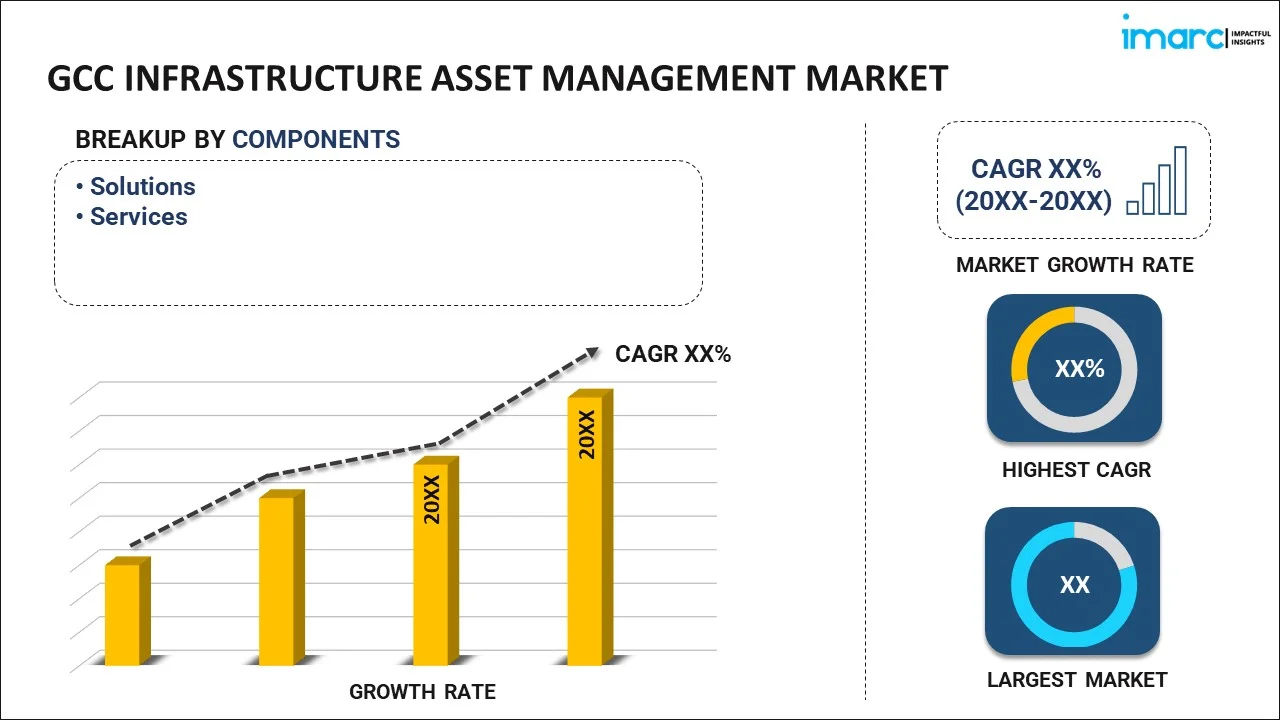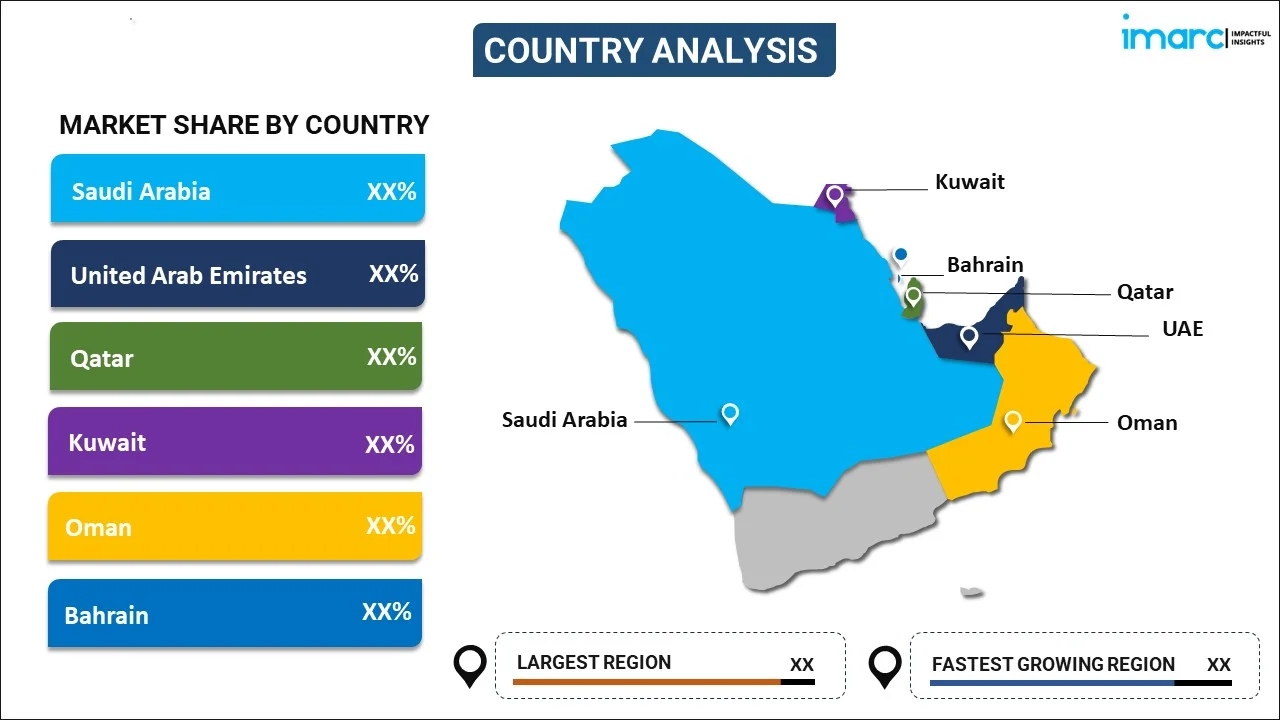
GCC Infrastructure Asset Management Market Report by Component (Solutions, Services), Application (Transportation, Energy Infrastructure, Water and Waste Infrastructure, Critical Infrastructure, and Others), Service Type (Strategic Asset Management, Operational Asset Management, Tactical Asset Management), and Country 2025-2033
Market Overview:
The GCC infrastructure asset management market size reached USD 973.8 Million in 2024. Looking forward, IMARC Group expects the market to reach USD 2,168.0 Million by 2033, exhibiting a growth rate (CAGR) of 8.6% during 2025-2033. The expansion of non-oil sectors, including tourism, manufacturing, and logistics, technological adoption in the region, and the growing well-managed infrastructure to support housing, transportation, and public services are some of the key factors driving the market.
|
Report Attribute
|
Key Statistics
|
|---|---|
|
Base Year
|
2024
|
|
Forecast Years
|
2025-2033
|
|
Historical Years
|
2019-2024
|
| Market Size in 2024 | USD 973.8 Million |
| Market Forecast in 2033 | USD 2,168.0 Million |
| Market Growth Rate 2025-2033 | 8.6% |
Infrastructure asset management is a strategic approach that focuses on the effective management, operation, maintenance, and rehabilitation of physical and organizational structures, facilities, and systems. These assets include roads, bridges, water supply, sewers, electrical grids, and other fundamental components of modern society. The primary goal of infrastructure asset management is to ensure that these assets are maintained at a desired level of service in the most cost-effective manner and that they meet the needs of the community. It involves a detailed understanding of the lifecycle of the assets, from design and construction through to decommissioning, along with ongoing analysis and monitoring. By employing tools such as risk management, long-term planning, resource allocation, and performance monitoring, infrastructure asset management aims to optimize investments and ensure that the infrastructure remains reliable, safe, and sustainable. This discipline aids in informed decision-making, aligning strategic goals with functional execution, and creating a balance between costs, risks, opportunities, and performance requirements. Moreover, infrastructure asset management plays a crucial role in the enhancement of the quality of life, supporting economic growth, and fostering sustainable development in modern societies.
GCC Infrastructure Asset Management Market Trends:
The GCC (Gulf Cooperation Council) region has unique market drivers for the infrastructure asset management industry, shaped by its particular economic, social, and political context. The region's robust economic growth and ambitious visions for future development, as laid out in strategic plans, drive substantial investment in infrastructure projects. These plans prioritize diversification away from oil dependency, leading to the expansion of non-oil sectors, including tourism, manufacturing, and logistics, all of which require significant infrastructure support. Additionally, urbanization is another major driver as cities across the GCC continue to grow rapidly. This urban expansion necessitates well-managed infrastructure to support housing, transportation, and public services. The region's harsh climatic conditions also underline the importance of adequate maintenance and lifecycle management of assets to ensure resilience and sustainability. Along with this, Public-Private Partnerships (PPPs) are gaining traction in the GCC as an effective means to fund infrastructure projects. This model stimulates investment in infrastructure development and related asset management services as both governments and private investors seek to optimize returns and performance. Therefore, this is significantly supporting the market. In addition, technological adoption in the region, including advancements in digitalization, IoT, and smart city initiatives, enables more effective and efficient asset management. These technologies offer opportunities for predictive maintenance, real-time monitoring, and enhanced decision-making, meeting modern urban environments' demands and industrial applications' demands. Apart from this, sustainability concerns are increasingly influencing the GCC's approach to infrastructure development and management. Furthermore, governments are implementing policies to promote environmental responsibility, energy efficiency, and water conservation, leading to a growing emphasis on sustainable asset management practices, which is creating a positive market outlook.
GCC Infrastructure Asset Management Market Segmentation:
IMARC Group provides an analysis of the key trends in each segment of the GCC infrastructure asset management market report, along with forecasts at the regional and country levels for 2025-2033. Our report has categorized the market based on component, application, and service type.
Component Insights:

- Solutions
- Services
The report has provided a detailed breakup and analysis of the market based on the component. This includes solutions and services.
Application Insights:
- Transportation
- Energy Infrastructure
- Water and Waste Infrastructure
- Critical Infrastructure
- Others
A detailed breakup and analysis of the market based on the application has also been provided in the report. This includes transportation, energy infrastructure, water and waste infrastructure, critical infrastructure, and others.
Service Type Insights:
- Strategic Asset Management
- Operational Asset Management
- Tactical Asset Management
The report has provided a detailed breakup and analysis of the market based on the service type. This includes strategic asset management, operational asset management, and tactical asset management.
Country Insights:

- Saudi Arabia
- UAE
- Qatar
- Bahrain
- Kuwait
- Oman
The report has also provided a comprehensive analysis of all the major regional markets, which include Saudi Arabia, UAE, Qatar, Bahrain, Kuwait, and Oman.
Competitive Landscape:
The report has also provided a comprehensive analysis of the competitive landscape in the market. Competitive analysis such as market structure, key player positioning, top winning strategies, competitive dashboard, and company evaluation quadrant has been covered in the report. Also, detailed profiles of all major companies have been provided.
GCC Infrastructure Asset Management Market Report Coverage:
| Report Features | Details |
|---|---|
| Base Year of the Analysis | 2024 |
| Historical Period | 2019-2024 |
| Forecast Period | 2025-2033 |
| Units | Million USD |
| Scope of the Report | Exploration of Historical and Forecast Trends, Industry Catalysts and Challenges, Segment-Wise Historical and Predictive Market Assessment:
|
| Components Covered | Solutions, Services |
| Applications Covered | Transportation, Energy Infrastructure, Water and Waste Infrastructure, Critical Infrastructure, Others |
| Services Types Covered | Strategic Asset Management, Operational Asset Management, Tactical Asset Management |
| Countries Covered | Saudi Arabia, UAE, Qatar, Bahrain, Kuwait, Oman |
| Customization Scope | 10% Free Customization |
| Post-Sale Analyst Support | 10-12 Weeks |
| Delivery Format | PDF and Excel through Email (We can also provide the editable version of the report in PPT/Word format on special request) |
Key Questions Answered in This Report:
- How has the GCC infrastructure asset management market performed so far and how will it perform in the coming years?
- What has been the impact of COVID-19 on the GCC infrastructure asset management market?
- What is the breakup of the GCC infrastructure asset management market on the basis of component?
- What is the breakup of the GCC infrastructure asset management market on the basis of application?
- What is the breakup of the GCC infrastructure asset management market on the basis of service type?
- What are the various stages in the value chain of the GCC infrastructure asset management market?
- What are the key driving factors and challenges in the GCC infrastructure asset management market?
- What is the structure of the GCC infrastructure asset management market and who are the key players?
- What is the degree of competition in the GCC infrastructure asset management market?
Key Benefits for Stakeholders:
- IMARC’s report offers a comprehensive quantitative analysis of various market segments, historical and current market trends, market forecasts, and dynamics of the GCC infrastructure asset management market from 2019-2033.
- The research study provides the latest information on the market drivers, challenges, and opportunities in the GCC infrastructure asset management market.
- Porter's five forces analysis assist stakeholders in assessing the impact of new entrants, competitive rivalry, supplier power, buyer power, and the threat of substitution. It helps stakeholders to analyze the level of competition within the GCC infrastructure asset management industry and its attractiveness.
- Competitive landscape allows stakeholders to understand their competitive environment and provides an insight into the current positions of key players in the market.
Need more help?
- Speak to our experienced analysts for insights on the current market scenarios.
- Include additional segments and countries to customize the report as per your requirement.
- Gain an unparalleled competitive advantage in your domain by understanding how to utilize the report and positively impacting your operations and revenue.
- For further assistance, please connect with our analysts.
 Inquire Before Buying
Inquire Before Buying
 Speak to an Analyst
Speak to an Analyst
 Request Brochure
Request Brochure
 Request Customization
Request Customization




.webp)




.webp)












